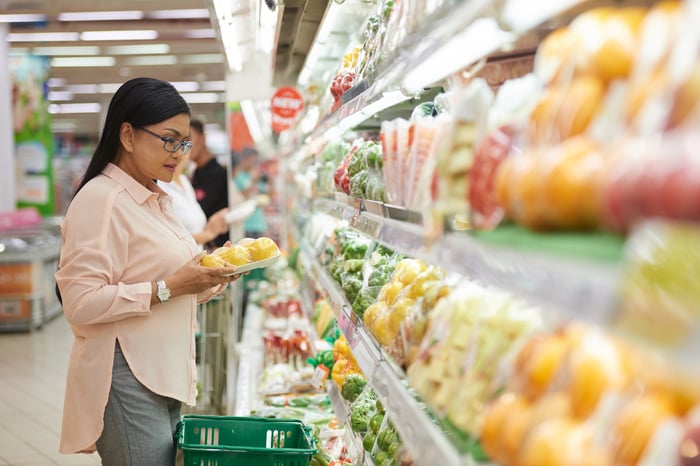Dingdong (Cayman) (DDL 6.48%), a leading Chinese on-demand e-commerce company, went public on June 29, 2021. For those who are new to the company, Dingdong resembles a Chinese version of Instacart where you can order groceries online and get them delivered to your home.
Backed by leading investors such as Tiger Global and SoftBank, Dingdong priced its shares at $23.50 per American depositary shares (ADS), raising a total of $110 million from the IPO.
Its stock rose to a high of $46 per share on the first day, giving back most of the gain before the closing bell rang.It is now trading close to its IPO price again, giving investors a second chance to buy into the stock. But before you buy in, let's run through Dingdong's business model, growth prospects, and risks.

Image source: Getty Images.
Dingdong's business model
Dingdong is an on-demand e-commerce company supplying fresh produce, seafood, meat, and other products to its customers. It operates its own fulfillment service, delivering almost 1 million orders per day with the goal of getting them to customers within 30 minutes. As of the first quarter of 2021, the company served 29 cities across China, reaching over 6.9 million monthly users.
To understand its business, investors will need to know the problems that it is trying to solve.
To start, China's agriculture industry is highly fragmented, which together with its inefficient supply chain, results in high prices and weak quality assurance of fresh produce to consumers. While the rise of the e-commerce industry has improved the situation, a lot of issues remain unsolved. For example, the perishable nature of fresh groceries makes it necessary that these products can get from farm to customers quickly and reliably within hours, not days. Meanwhile, many modern consumers find walking around wet markets searching for fresh produce -- something that their parents and grandparents have often done in the past -- to be time-consuming. Many times, they might not even find what they're looking for in these traditional markets.
Enter Dingdong.
The company buys directly from farmers in bulk, bringing a variety of high-quality products at attractive prices to its customers. To ensure the quality of the products, Dingdong applies strict quality control across its entire supply chain. Operating its own fulfillment service further improves quality control and delivery time. The result is that customers can buy high-quality groceries at low prices, receiving them quickly after placing orders on Dingdong's app.
And so far, customers seem to like the service, which explains the rapid rise in Dingdong's gross merchandise volume (GMV) -- up more than 17-fold from 2018 to a high of 13 billion yuan ($2 billion) in 2020. Similarly, its revenue almost tripled from 3.9 billion yuan ($592 million) in 2019 to 11.4 billion yuan ($1.7 billion) in 2020. While top-line growth has been impressive, the company remains unprofitable over the last two years.
Dingdong's prospects -- and risks
While the company has grown at a breathtaking rate, there are good reasons to believe that even better days are yet to come.
According to its prospectus, the on-demand e-commerce market size is expected to grow at a compound annual growth rate (CAGR) of 31.8% between 2020 and 2025 to reach 512 billion yuan ($79 billion). Beyond that, the total fresh groceries and daily necessities industry in China was 11.1 trillion yuan ($1.7 trillion) in 2020 and is expected to reach 15.2 trillion yuan ($2.3 trillion) in 2025. The huge addressable market suggests that Dingdong has plenty of room to grow in the coming years. For perspective, its 2020 GMV of 13 billion yuan ($2.0 billion) gives it just above 1% in total market share.
There are many ways Dingdong can grow its business. It can increase its customer base both in existing markets and by entering new markets. Also, it can grow the spending of existing customers by continuing to please them with a wide variety of products at good prices. To this end, it can leverage its data insights to personalize its offerings, which should enhance customer experience and further improve customer monetization.
Although Dingdong's prospects look bright, there are risks that investors should know.
It started operating only in 2017, making it difficult for investors to assess the long-term viability of its business. Besides, it competes in a highly competitive industry against e-commerce giants like Alibaba, Pinduoduo, and Meituan. While Dingdong's value proposition is clear -- a wide selection of cheap and fresh products delivered quickly -- it must continue to delights its users or face the risk of losing relevance to these bigger players.
Also, the company remains unprofitable, and it will likely remain in red for the foreseeable future as it continues to invest in growth. The good news is that Dingdong's business benefits from economies of scale -- as it grows bigger, it will have a lower unit cost both in terms of procurement and operations. This, in turn, will help improve its margins and move the company toward profitability.
Should investors buy the stock now?
It's not hard to see why Dingdong has good prospects ahead. It is providing a superior shopping experience for customers to buy daily necessities, and at the same time, modernizing the agriculture supply chain in China. And with a local market share of less than 1%, Dingdong has a massive runway ahead.
Still, investors should not rush into the stock. After all, the company is still very young and will need to prove itself a worthy candidate for their hard-earned cash. Potential investors should track the company's performance over the next few quarters before making their next move.


